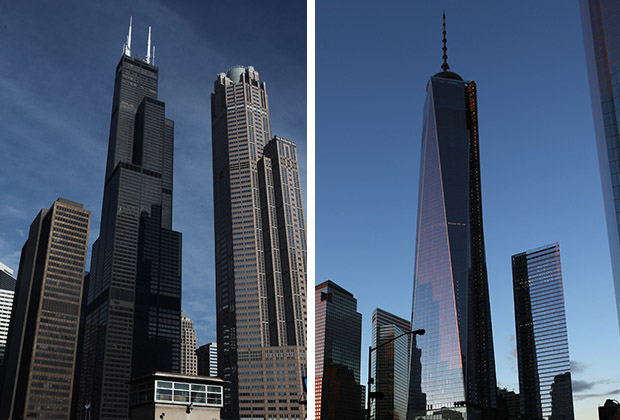As the Council on Tall Buildings and Urban Habitat meets this week to determine the tallest building in the Western Hemisphere, I imagine the conversation will be a civil discourse on architectural distinction, the symbolic height of our nation's great edifices, and the 21st century's true meaning of tallestness.
Here's what the council ought to say about this whole debate:
Forget the mast.
Or antenna. Or spire. Or whatever you call your pole. If you can't stand on it, it is not part of the building.
Here's a graphic that helpfully explains the terms of this week's debate:
"Arbiters of world building heights" will decide if One WTC is the new tallest building in the western hemisphere pic.twitter.com/m2w5gDlzwC
— Scott Bixby (@scottbix) November 11, 2013
So, basically, you have a 1,450-foot-tall building in Chicago and a 1,368-foot one in NYC. The one in New York has a big 400-foot pole on top, which is, like, way bigger than Chicago's also respectable but not as gigantic pole.
Given the topic, you will probably not be surprised by its tone, with even highbrow outlets like NPR titling a story, "Size Does Matter." Heh. The story does get at the core of the question—on building measurement, anyway:
"What it really comes down to is this: What are we measuring?" asks [council executive director Anthony] Wood. "If we are measuring man's ability to put materials above the plane of the earth, then it should just be material, irrespective of what that material or function is. Or, are we measuring man's ability to put man above the plane of the earth? Are we going with the highest occupied floor? Or something in between?"
Wood, however, is a rare beacon of reason in a discussion that sounds a lot like an argument in a bar between two cities.
Here's the New York Daily News being itself: "The Second City—apparently tired of looking up at New York—could be conspiring to steal the title of the nation's tallest building."
And here's CBS Chicago stroking New York's ego while simultaneously claiming superiority: "From 1908 until 1974, New Yorkers had the tallest buildings in the country, but then Chicago overtook them in the race to the sky."
More stories from each city are basically saying the same thing, but one of the most telling sets of quotes is a man-on-the-street section from the NPR piece:
"It's a fact. It's taller," says Jerry Romano of New Jersey. "It doesn't matter to me. I'm just stating facts."
Veronica Smalls of Harlem agrees. "It has to be the tallest," she says.
"Not one of the tallest," interrupts her friend Tyreek Jones of Brooklyn, "'cause New York City needs to be known as No. 1."
This sounds familiar; I lived in NYC for 8 years and have been in Chicago since 2013. Tyreek is telling the truth. New York really does need to be number one. It has to. If NYC isn't the place where you find the most beautiful people, the most delicious food, the greatest clothes, the finest arts, then why do we pay so much, and put up with so much, and fight so hard to live here? The tallest building? Right! That's What I Love About New York™. Now here, please, take 58% of my income as rent.
But Chicago's comeback has to be its buildings. Fine, New York, you can say you've got us on the weather, the food, the clothes, the baseball, the style, the money, whatever, but the buildings are better here and don't you mess with that. If you wanted a bigger building, you should have built more building.
What this whole thing really measures isn't the size of a pair of buildings—it's the size of each city's insecurity. New York has its hollow confidence, and Chicago has its inferiority complex. Each is painful, but both can be soothed by the balm of the biggest building. Helpful reminder: The reason that Western Hemisphere asterisk has to be applied to the Willis / World Trade debate is because, among the tallest buildings worldwide, these two barely make the top 10.
The tallest building thing is just a stand-in for the real question: Which is the better city? You'll need a different kind of Council on Urban Habitat to really get to the bottom of that.
Update:
It's over. NYC is the tallest in the US.
One World Trade Center will be nation's tallest building, not Willis Tower. http://t.co/FwcOaFXbDk via @BlairKamin
— Chicago Tribune (@chicagotribune) November 12, 2013
But, honestly:
if guyed masts count in tower height, blanchard, ND has us all beat http://t.co/NowjI2TjTi
— Whet Moser (@whet) November 12, 2013



